A Review of Models for Photovoltaic Crack and Hotspot Prediction
Abstract
:1. Introduction
2. Causes of Reduced Performance and PV Failures
2.1. Failure Caused by Climate Stress
- Humidity: Humidity can affect the performance of polymers, which can happen when it enters the PV module, the active layer (semiconductor), and metallic elements like fingers, grids, and connectors. It can also affect the adhesion between polymer layers in combination with heat;
- Snow and wind: snow can cause heavy static mechanical loads and wind can cause both static and dynamic loads on PV modules;
- Hail: hail causes impact stress, depending on its size and velocity, and can have a high local impact;
- High temperature: High temperature can change the polymeric material properties drastically if the glass transition point is reached. When there are temporary high-temperature fluctuations, this can cause thermo-mechanical stress. The thermal stress concentrates at the interfaces between layers, which can result in considerable module failure and degradation rates. This can be seen in the thermal cycling tests performed on PV cells/modules [3,4,5];
- Air: air with high salt concentrations can cause the corrosion of metallic components and degradation of polymers, especially in areas near the sea;
- Sand and dust: Both elements combined with wind can be abrasive or, with many dry and wet cycles, result in layer build up on the panels, especially in the Sun Belt area of the continents. Their deposition and accumulation adversely affect the PV panel’s energy yield by either reflecting or absorbing the solar radiation [6]. More particularly, dust, depending on its size and density, causes a reduction in transmittance, resulting in particle shading. Additionally, the difference in temperature between dusted and non-dusted areas causes a reduction in open and short-circuit voltage. A summary of experiments that assess PV power output affected by dust is outlined by [6];
- Gases: gases of certain types can, alone or in combination with humidity, cause corrosion, particularly in areas near industrial plants or main roads.
2.2. PV Failure Modes
2.3. Root Cause of Microcracks
2.4. PV Hotspots
2.5. Detection and Characteristics of PV Microcracks
- Diagonal crack (+45°);
- Diagonal crack (−45°);
- Parallel to busbars crack (vertical);
- Perpendicular to busbars crack (horizontal);
- Multiple directions crack.
3. Literature on the Performance Modelling of PV Systems
4. Results and Discussions
4.1. Modelling Solar Cell Microcracks
4.2. Modelling PV Performance Output
4.3. PV Hotspot Mitigation Techniques
5. Comparative Study
6. Conclusions
Author Contributions
Funding
Data Availability Statement
Conflicts of Interest
References
- Wohlgemuth, J.H.; Cunningham, D.W.; Monus, P.; Miller, J.; Nguyen, A. Long Term Reliability of Photovoltaic Modules. In Proceedings of the IEEE 4th World Conference on Photovoltaic Energy Conference, Waikoloa, HI, USA, 7–12 May 2006; pp. 2050–2053. [Google Scholar] [CrossRef]
- Skoczek, A.; Sample, T.; Dunlop, E.D. The results of performance measurements of field-aged crystalline silicon photovoltaic modules. Prog. Photovoltaics: Res. Appl. 2009, 17, 227–240. [Google Scholar] [CrossRef]
- Khan, F.; Kim, J.H. Performance Degradation Analysis of c-Si PV Modules Mounted on a Concrete Slab under Hot-Humid Conditions Using Electroluminescence Scanning Technique for Potential Utilization in Future Solar Roadways. Materials 2019, 12, 4047. [Google Scholar] [CrossRef] [PubMed]
- Zhu, J.; Koehl, M.; Hoffmann, S.; Berger, K.A.; Zamini, S.; Bennett, I.; Gerritsen, E.; Malbranche, P.; Pugliatti, P.; Di Stefano, A.; et al. Changes of solar cell parameters during damp-heat exposure. Prog. Photovolt. Res. Appl. 2016, 24, 1346–1358. [Google Scholar] [CrossRef]
- Kawai, S.; Tanahashi, T.; Fukumoto, Y.; Tamai, F.; Masuda, A.; Kondo, M. Causes of Degradation Identified by the Extended Thermal Cycling Test on Commercially Available Crystalline Silicon Photovoltaic Modules. IEEE J. Photovolt. 2017, 7, 1511–1518. [Google Scholar] [CrossRef]
- Santhakumari, M.; Sagar, N. A review of the environmental factors degrading the performance of silicon wafer-based photovoltaic modules: Failure detection methods and essential mitigation techniques. Renew. Sustain. Energy Rev. 2019, 110, 83–100. [Google Scholar] [CrossRef]
- Khan, F.; Baek, S.-H.; Kim, J. Wide range temperature dependence of analytical photovoltaic cell parameters for silicon solar cells under high illumination conditions. Appl. Energy 2016, 183, 715–724. [Google Scholar] [CrossRef]
- Ngo, T.; Heta, Y.; Doi, T.; Masuda, A. Effects of UV on power degradation of photovoltaic modules in combined acceleration tests. Jpn. J. Appl. Phys. 2016, 55, 052301. [Google Scholar] [CrossRef]
- Papargyri, L.; Theristis, M.; Kubicek, B.; Krametz, T.; Mayr, C.; Papanastasiou, P.; Georghiou, G.E. Modelling and experimental investigations of microcracks in crystalline silicon photovoltaics: A review. Renew. Energy 2020, 145, 2387–2408. [Google Scholar] [CrossRef]
- Abdelhamid, M.; Singh, R.; Omar, M. Review of Microcrack Detection Techniques for Silicon Solar Cells. IEEE J. Photovolt. 2013, 4, 514–524. [Google Scholar] [CrossRef]
- Köntges, M.; Kajari-Schröder, S.; Kunze, I.; Jahn, U. Crack Statistic of Crystalline Silicon Photovoltaic Modules. In Proceedings of the 26th European Photovoltaic Solar Energy Conference and Exhibition, Hamburg, Germany, 5–9 September 2011; pp. 3290–3294. [Google Scholar] [CrossRef]
- Brun, X.F.; Melkote, S.N. Analysis of stresses and breakage of crystalline silicon wafers during handling and transport. Sol. Energy Mater. Sol. Cells 2009, 93, 1238–1247. [Google Scholar] [CrossRef]
- Sander, M.; Henke, B.; Schweizer, S.; Ebert, M.; Bagdahn, J. PV module defect detection by combination of mechanical and electrical analysis methods. In Proceedings of the 35th IEEE Photovoltaic Specialists Conference, Honolulu, HI, USA, 20–25 June 2010; pp. 1765–1769. [Google Scholar] [CrossRef]
- Köntges, M.; Siebert, M.; Morlier, A.; Illing, R.; Bessing, N.; Wegert, F. Impact of transportation on silicon wafer-based photovoltaic modules. Prog. Photovolt. Res. Appl. 2016, 24, 1085–1095. [Google Scholar] [CrossRef]
- Dhimish, M.; Lazaridis, P.I. An empirical investigation on the correlation between solar cell cracks and hotspots. Sci. Rep. 2021, 11, 1–11. [Google Scholar] [CrossRef] [PubMed]
- Kaule, F.; Wang, W.; Schoenfelder, S. Modeling and testing the mechanical strength of solar cells. Sol. Energy Mater. Sol. Cells 2014, 120, 441–447. [Google Scholar] [CrossRef]
- Popovich, V.A.; Maris, M.P.F.H.L.V.; Janssen, M.; Bennett, I.J.; Richardson, I.M. Understanding the Properties of Silicon Solar Cells Aluminium Contact Layers and Its Effect on Mechanical Stability. Mater. Sci. Appl. 2013, 4, 118–127. [Google Scholar] [CrossRef]
- Popovich, V.A.; Janssen, M.; Bennett, I.J.; Richardson, I.M. Microstructure and mechanical properties of a screen-printed silver front side solar cell contact. In EPD Congress 2015; Springer International: New York, NY, USA, 2016; pp. 265–272. [Google Scholar]
- Israil, M.; Anwar, S.A.; Abdullah, M.Z. Automatic detection of micro-crack in solar wafers and cells: A review. Trans. Inst. Meas. Control 2013, 35, 606–618. [Google Scholar] [CrossRef]
- Rupnowski, P.; Sopori, B. Strength of silicon wafers: Fracture mechanics approach. Int. J. Fract. 2009, 155, 67–74. [Google Scholar] [CrossRef]
- Gonzalez, M.; Govaerts, J.; Labie, R.; Wolf, I.D.; Baert, K. Thermo-mechanical challenges of advanced solar cell modules. In Proceedings of the 23rd European photovoltaic solar energy conference, Valencia, Spain, 1–5 September 2008; pp. 258–260. [Google Scholar] [CrossRef]
- Popovich, V.; Yunus, A.; Janssen, M.; Richardson, I.; Bennett, I. Effect of silicon solar cell processing parameters and crystallinity on mechanical strength. Sol. Energy Mater. Sol. Cells 2011, 95, 97–100. [Google Scholar] [CrossRef]
- Bayrak, F.; Oztop, H.F. Effects of static and dynamic shading on thermodynamic and electrical performance for photovoltaic panels. Appl. Therm. Eng. 2020, 169, 114900. [Google Scholar] [CrossRef]
- Bouraiou, A.; Hamouda, M.; Chaker, A.; Mostefaoui, M.; Lachtar, S.; Sadok, M.; Boutasseta, N.; Othmani, M.; Issam, A. Analysis and evaluation of the impact of climatic conditions on the photovoltaic modules performance in the desert environment. Energy Convers. Manag. 2015, 106, 1345–1355. [Google Scholar] [CrossRef]
- Luo, W.; Khoo, Y.S.; Hacke, P.; Naumann, V.; Lausch, D.; Harvey, S.P.; Singh, J.P.; Chai, J.; Wang, Y.; Aberle, A.G.; et al. Potential-induced degradation in photovoltaic modules: A critical review. Energy Environ. Sci. 2017, 10, 43–68. [Google Scholar] [CrossRef]
- Ko, S.W.; Ju, Y.C.; Hwang, H.M.; So, J.H.; Jung, Y.-S.; Song, H.-J.; Song, H.-E.; Kim, S.-H.; Kang, G.H. Electric and thermal characteristics of photovoltaic modules under partial shading and with a damaged bypass diode. Energy 2017, 128, 232–243. [Google Scholar] [CrossRef]
- Monastyrskyi, A.; Ostapenko, S.; Polupan, O.; Maeckel, H.; Vazquez, M. Resonance Ultrasonic Vibrations for in-line crack detection in silicon wafers and solar cells. In Proceedings of the 33rd IEEE Photovoltaic Specialists Conference, San Diego, CA, USA, 11–16 May 2008; pp. 1–6. [Google Scholar] [CrossRef]
- Ostapenko, S.; Dallas, W.; Hess, D.; Polupan, O.; Wohlgemuth, J. Crack Detection and Analyses using Resonance Ultrasonic Vibrations in crystalline silicon wafers. In Proceedings of the Crystalline 4th World Conference on Photovoltaic Energy Conversion, WCPEC-4, Waikoloa, HI, USA, 7–12 May 2006; pp. 920–923. [Google Scholar] [CrossRef]
- Liu, Z.; Peters, M.; Shanmugam, V.; Khoo, Y.S.; Guo, S.; Stangl, R.; Aberle, A.G.; Wong, J. Luminescence imaging analysis of light harvesting from inactive areas in crystalline silicon PV modules. Sol. Energy Mater. Sol. Cells 2016, 144, 523–531. [Google Scholar] [CrossRef]
- Zhu, Y.; Juhl, M.; Trupke, T.; Hameiri, Z. Photoluminescence Imaging of Silicon Wafers and Solar Cells With Spatially Inhomogeneous Illumination. IEEE J. Photovolt. 2017, 7, 1087–1091. [Google Scholar] [CrossRef]
- Bhoopathy, R.; Kunz, O.; Juhl, M.; Trupke, T.; Hameiri, Z. Outdoor photoluminescence imaging of photovoltaic modules with sunlight excitation. Prog. Photovolt. Res. Appl. 2018, 26, 69–73. [Google Scholar] [CrossRef]
- Dhimish, M.; Holmes, V.; Mather, P.; Sibley, M. Novel hot spot mitigation technique to enhance photovoltaic solar panels output power performance. Sol. Energy Mater. Sol. Cells 2018, 179, 72–79. [Google Scholar] [CrossRef]
- Dhimish, M.; Holmes, V.; Mehrdadi, B.; Dales, M. The impact of cracks on photovoltaic power performance. J. Sci. Adv. Mater. Devices 2017, 2, 199–209. [Google Scholar] [CrossRef]
- Hu, X.; Chen, T.; Xue, J.; Weng, G.; Chen, S.; Akiyama, H.; Zhu, Z. Absolute Electroluminescence Imaging Diagnosis of GaAs Thin-Film Solar Cells. IEEE Photon. J. 2017, 9, 1–9. [Google Scholar] [CrossRef]
- Dhimish, M.; Holmes, V.; Mather, P. Novel Photovoltaic Micro Crack Detection Technique. IEEE Trans. Device Mater. Reliab. 2019, 19, 304–312. [Google Scholar] [CrossRef]
- Pramana, P.A.A.; Dalimi, R. Hotspot Detection Method in Large Capacity Photovoltaic (PV) Farm. IOP Conf. Ser. Mater. Sci. Eng. 2020, 982, 012019. [Google Scholar] [CrossRef]
- Sulas-Kern, D.B.; Johnston, S.; Owen-Bellini, M.; Terwilliger, K.; Meydbray, J.; Spinella, L.; Sinha, A.; Schelhas, L.T.; Jordan, D.C. UV-Fluorescence Imaging of Silicon PV Modules After Outdoor Aging and Accelerated Stress Testing. In Proceedings of the IEEE Photovoltaic Specialists Conference, Online Conference, 15 June–21 August 2020; pp. 1444–1448. [Google Scholar] [CrossRef]
- Gilleland, B.; Hobbs, W.B.; Richardson, J.B. High Throughput Detection of Cracks and Other Faults in Solar PV Modules Using a High-Power Ultraviolet Fluorescence Imaging System. In Proceedings of the 2019 IEEE 46th Photovoltaic Specialists Conference (PVSC), Chicago, IL, USA, 16–21 June 2019. [Google Scholar] [CrossRef]
- Kontges, M.; Morlier, A.; Eder, G.; Fleis, E.; Kubicek, B.; Lin, J. Review: Ultraviolet Fluorescence as Assessment Tool for Photovoltaic Modules. IEEE J. Photovolt. 2020, 10, 616–633. [Google Scholar] [CrossRef]
- Patel, A.P.; Sinha, A.; Tamizhmani, G. Field-Aged Glass/Backsheet and Glass/Glass PV Modules: Encapsulant Degradation Comparison. IEEE J. Photovolt. 2019, 10, 607–615. [Google Scholar] [CrossRef]
- Chiou, Y.; Liu, J.; Liang, Y. Micro crack detection of multi-crystalline silicon solar wafer using machine vision techniques. Sens. Rev. 2011, 31, 154–165. [Google Scholar] [CrossRef]
- Köntges, M.; Kunze, I.; Kajari-Schröder, S.; Breitenmoser, X.; Bjørneklett, B. The risk of power loss in crystalline silicon based photovoltaic modules due to micro-cracks. Sol. Energy Mater. Sol. Cells 2011, 95, 1131–1137. [Google Scholar] [CrossRef]
- Addabbo, P.; Angrisano, A.; Bernardi, M.L.; Gagliarde, G.; Mennella, A.; Nisi, M.; Ullo, S. A UAV infrared measurement approach for defect detection in photovoltaic plants. In Proceedings of the IEEE International Workshop on Metrology for AeroSpace (MetroAeroSpace), Padua, Italy, 21–23 June 2017; pp. 345–350. [Google Scholar] [CrossRef]
- Zhang, P.; Zhang, L.; Wu, T.; Zhang, H.; Sun, X. Detection and location of fouling on photovoltaic panels using a drone-mounted infrared thermography system. J. Appl. Remote Sens. 2017, 11, 16026. [Google Scholar] [CrossRef]
- Alsafasfeh, M.; Abdel-Qader, I.; Bazuin, B.; Alsafasfeh, Q.; Su, W. Unsupervised Fault Detection and Analysis for Large Photovoltaic Systems Using Drones and Machine Vision. Energies 2018, 11, 2252. [Google Scholar] [CrossRef]
- Henry, C.; Poudel, S.; Lee, S.-W.; Jeong, H. Automatic Detection System of Deteriorated PV Modules Using Drone with Thermal Camera. Appl. Sci. 2020, 10, 3802. [Google Scholar] [CrossRef]
- Dhimish, M.; Schofield, N.; Attya, A. Insights on the Degradation and Performance of 3000 Photovoltaic Installations of Various Technologies Across the United Kingdom. IEEE Trans. Ind. Inform. 2020, 17, 5919–5926. [Google Scholar] [CrossRef]
- Short, W.; Packey, D.; Holt, T. A manual for the economic evaluation of energy efficiency and renewable energy technologies. In A Manual for the Economic Evaluation of Energy Efficiency and Renewable Energy Technologies; Office of Scientific and Technical Information (OSTI): Washington, DC, USA, 1995. [Google Scholar]
- Jordan, D.C.; Silverman, T.J.; Sekulic, B.; Kurtz, S.R. PV degradation curves: Non-linearities and failure modes. Prog. Photovoltaics Res. Appl. 2016, 25, 583–591. [Google Scholar] [CrossRef]
- Jordan, D.C.; Silverman, T.J.; Wohlgemuth, J.H.; Kurtz, S.R.; VanSant, K.T. Photovoltaic failure and degradation modes. Prog. Photovoltaics Res. Appl. 2017, 25, 318–326. [Google Scholar] [CrossRef]
- Dhimish, M. Micro cracks distribution and power degradation of polycrystalline solar cells wafer: Observations constructed from the analysis of 4000 samples. Renew. Energy 2019, 145, 466–477. [Google Scholar] [CrossRef]
- Grunow, P.; Clemens, P.; Hoffmann, V.; Litzenburger, B.; Podlowski, L. Influence of micro cracks in multi-crystalline silicon solar cells on the reliability of PV modules. In Proceedings of the European Photovoltaic Solar Energy Conference and Exhibition (EU PVSEC), Barcelona, Spain, 6–10 June 2005. [Google Scholar]
- Dhimish, M.; Holmes, V.; Dales, M.; Mather, P.; Sibley, M.; Chong, B.; Zhang, L. The impact of cracks on the performance of photovoltaic modules. In Proceedings of the IEEE Manchester PowerTech, Manchester, UK, 18–22 June 2017; pp. 1–6. [Google Scholar] [CrossRef]
- Spataru, S.; Hacke, P.; Sera, D. Automatic detection and evaluation of solar cell micro-cracks in electroluminescence images using matched filters. In Proceedings of the IEEE 43rd Photovoltaic Specialists Conference (PVSC), Portland, OR, USA, 5–10 June 2016; pp. 1602–1607. [Google Scholar] [CrossRef]
- Bdour, M.; Al-Sadi, A. Analysis of different microcracks shapes and the effect of each shape on performance of PV modules. IOP Conf. Series Mater. Sci. Eng. 2020, 876, 012005. [Google Scholar] [CrossRef]
- Bdour, M.; Dalala, Z.; Al-Addous, M.; Radaideh, A.; Al-Sadi, A. A Comprehensive Evaluation on Types of Microcracks and Possible Effects on Power Degradation in Photovoltaic Solar Panels. Sustainability 2020, 12, 6416. [Google Scholar] [CrossRef]
- Dolara, A.; Leva, S.; Manzolini, G.; Niccolai, A.; Votta, L. Impact of Cell Microcracks Size and Spatial Distribution on Output Power of PV Modules. In Proceedings of the IEEE International Conference on Environment and Electrical Engineering and 2018 IEEE Industrial and Commercial Power Systems Europe (EEEIC/I&CPS Europe), Palermo, Italy, 12–15 June 2018; pp. 1–6. [Google Scholar] [CrossRef]
- Dolara, A.; Lazaroiu, G.C.; Leva, S.; Manzolini, G.; Votta, L. Snail Trails and Cell Microcrack Impact on PV Module Maximum Power and Energy Production. IEEE J. Photovolt. 2016, 6, 1269–1277. [Google Scholar] [CrossRef]
- Jordan, D.C.; Marion, B.; Deline, C.; Barnes, T.; Bolinger, M. PV field reliability status—Analysis of 100,000 solar systems. Prog. Photovolt. Res. Appl. 2020, 28, 739–754. [Google Scholar] [CrossRef]
- Zarmai, M.T.; Ekere, N.N.; Oduoza, C.; Amalu, E. A review of interconnection technologies for improved crystalline silicon solar cell photovoltaic module assembly. Appl. Energy 2015, 154, 173–182. [Google Scholar] [CrossRef]
- Dhimish, M.; Hu, Y.; Schofield, N.; Vieira, R.G. Mitigating Potential-Induced Degradation (PID) Using SiO2 ARC Layer. Energies 2020, 13, 5139. [Google Scholar] [CrossRef]
- Li, G.; Akram, M.; Jin, Y.; Chen, X.; Zhu, C.; Ahmad, A.; Arshad, R.; Zhao, X. Thermo-mechanical behavior assessment of smart wire connected and busbarPV modules during production, transportation, and subsequent field loading stages. Energy 2019, 168, 931–945. [Google Scholar] [CrossRef]
- Assmus, M.; Jack, S.; Weiss, K.-A.; Koehl, M. Measurement and simulation of vibrations of PV-modules induced by dynamic mechanical loads. Prog. Photovolt. Res. Appl. 2011, 19, 688–694. [Google Scholar] [CrossRef]
- Dong, J.; Yang, H.; Lu, X.; Zhang, H.; Peng, J. Comparative Study on Static and Dynamic Analyses of an Ultra-thin Double-Glazing PV Module Based on FEM. Energy Procedia 2015, 75, 343–348. [Google Scholar] [CrossRef]
- Kilikevičius, A.; Čereška, A.; Kilikevičienė, K. Analysis of external dynamic loads influence to photovoltaic module structural performance. Eng. Fail. Anal. 2016, 66, 445–454. [Google Scholar] [CrossRef]
- Beinert, A.; Romer, P.; Büchler, A.; Haueisen, V.; Aktaa, J.; Eitner, U. Thermomechanical stress analysis of PV module production processes by Raman spectroscopy and FEM simulation. Energy Procedia 2017, 124, 464–469. [Google Scholar] [CrossRef]
- Hasan, O.; Arif, A.F.M.; Siddiqui, M.U. Finite Element Modeling and Analysis of Photovoltaic Modules. In Proceedings of the ASME In-ternational Mechanical Engineering Congress and Exposition, Proceedings (IMECE), Houston, TX, USA, 9–15 November 2012; pp. 495–505. [Google Scholar] [CrossRef]
- Majd, A.E.; Ekere, N.N. Crack initiation and growth in PV module interconnection. Sol. Energy 2020, 206, 499–507. [Google Scholar] [CrossRef]
- Fries, T.-P. Extended Finite Element Methods (XFEM). In Encyclopedia of Continuum Mechanics; Springer: Berlin/Heidelberg, Germany, 2018; pp. 1–10. [Google Scholar]
- ABAQUS. Abaqus 6.11 Theory Manual. 2017. Available online: http://130.149.89.49:2080/v6.11/pdf_books/THEORY.pdf (accessed on 13 September 2021).
- Infuso, A.; Corrado, M.; Paggi, M. Image analysis of polycrystalline solar cells and modelling of intergranular and transgranular cracking. J. Eur. Ceram. Soc. 2014, 34, 2713–2722. [Google Scholar] [CrossRef]
- Ahmar, J.A.; Wiese, S. Analysis and simulation of cracks and micro cracks in PV cells. In Proceedings of the 14th International Conference on Thermal, Mechanical and Multi-Physics Simulation and Experiments in Microelectronics and Microsystems (EuroSimE), Wroclaw, Poland, 15–17 April 2013; pp. 1–4. [Google Scholar] [CrossRef]
- Dhimish, M.; D’Alessandro, V.; Daliento, S. Investigating the Impact of Cracks on Solar Cells Performance: Analysis Based on Nonuniform and Uniform Crack Distributions. IEEE Trans. Ind. Inform. 2021, 18, 1684–1693. [Google Scholar] [CrossRef]
- Zhu, Y.; Heinz, F.D.; Juhl, M.; Schubert, M.C.; Trupke, T.; Hameiri, Z. Photoluminescence Imaging at Uniform Excess Carrier Density Using Adaptive Nonuniform Excitation. IEEE J. Photovolt. 2018, 8, 1787–1792. [Google Scholar] [CrossRef]
- Su, B.; Chen, H.Y.; Chen, P.; Bian, G.-B.; Liu, K.; Liu, W. Deep Learning-Based Solar-Cell Manufacturing Defect Detection With Complementary Attention Network. IEEE Trans. Ind. Inform. 2020, 17, 4084–4095. [Google Scholar] [CrossRef]
- Sinha, P.; Wade, A. Addressing Hotspots in the Product Environmental Footprint of CdTe Photovoltaics. In Proceedings of the 43rd Photovoltaic Specialists Conference (PVSC), Portland, OR, USA, 5–10 June 2017; pp. 2005–2010. [Google Scholar] [CrossRef]
- Dhimish, M.; Mather, P.; Holmes, V. Evaluating Power Loss and Performance Ratio of Hot-Spotted Photovoltaic Modules. IEEE Trans. Electron. Devices 2018, 65, 5419–5427. [Google Scholar] [CrossRef]
- Dhimish, M.; Badran, G. Photovoltaic Hot-Spots Fault Detection Algorithm Using Fuzzy Systems. IEEE Trans. Device Mater. Reliab. 2019, 19, 671–679. [Google Scholar] [CrossRef]
- Dhimish, M.; Chen, Z. Novel Open-Circuit Photovoltaic Bypass Diode Fault Detection Algorithm. IEEE J. Photovolt. 2019, 9, 1819–1827. [Google Scholar] [CrossRef]
- Vieira, R.; Araújo, F.D.; Dhimish, M.; Guerra, M. A Comprehensive Review on Bypass Diode Application on Photovoltaic Modules. Energies 2020, 13, 2472. [Google Scholar] [CrossRef]
- Huang, J.-M.; Wai, R.-J.; Yang, G.-J. Design of Hybrid Artificial Bee Colony Algorithm and Semi-Supervised Extreme Learning Machine for PV Fault Diagnoses by Considering Dust Impact. IEEE Trans. Power Electron. 2020, 35, 7086–7099. [Google Scholar] [CrossRef]
- Zhao, Y.; Ball, R.; Mosesian, J.; Palma, J.-F.D.; Lehman, B. Graph-Based Semi-supervised Learning for Fault Detection and Classification in Solar Photovoltaic Arrays. IEEE Trans. Power Electron. 2014, 30, 2848–2858. [Google Scholar] [CrossRef]
- D’Alessandro, V.; Guerriero, P.; Daliento, S. A Simple Bipolar Transistor-Based Bypass Approach for Photovoltaic Modules. IEEE J. Photovolt. 2013, 4, 405–413. [Google Scholar] [CrossRef]
- Liu, W.; Badel, A.; Formosa, F.; Zhao, C.; Zhu, Q.; Hu, G. Comparative Case Study on the Self-Powered Synchronous Switching Harvesting Circuits with BJT or MOSFET Switches. IEEE Trans. Power Electron. 2018, 33, 9506–9519. [Google Scholar] [CrossRef]
- Yousefzadeh, B.; Makinwa, K.A.A. A BJT-Based Temperature-to-Digital Converter With a ±0.25 °C 3σ-Inaccuracy From −40 °C to +180 °C Using Heater-Assisted Voltage Calibration. IEEE J. Solid-State Circuits 2019, 55, 369–377. [Google Scholar] [CrossRef]
- Dhimish, M.; Badran, G. Current limiter circuit to avoid photovoltaic mismatch conditions including hot-spots and shading. Renew. Energy 2019, 145, 2201–2216. [Google Scholar] [CrossRef]
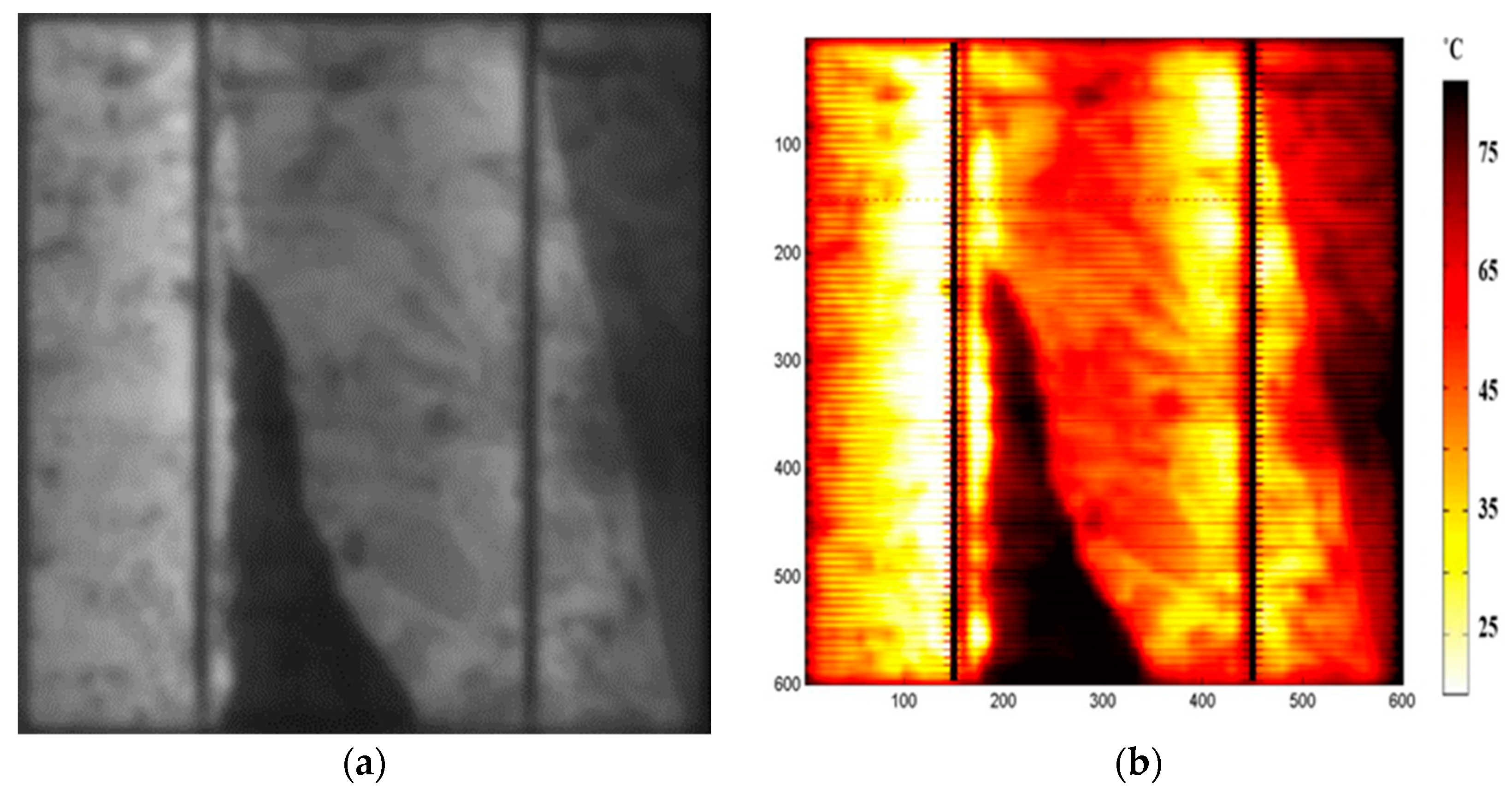
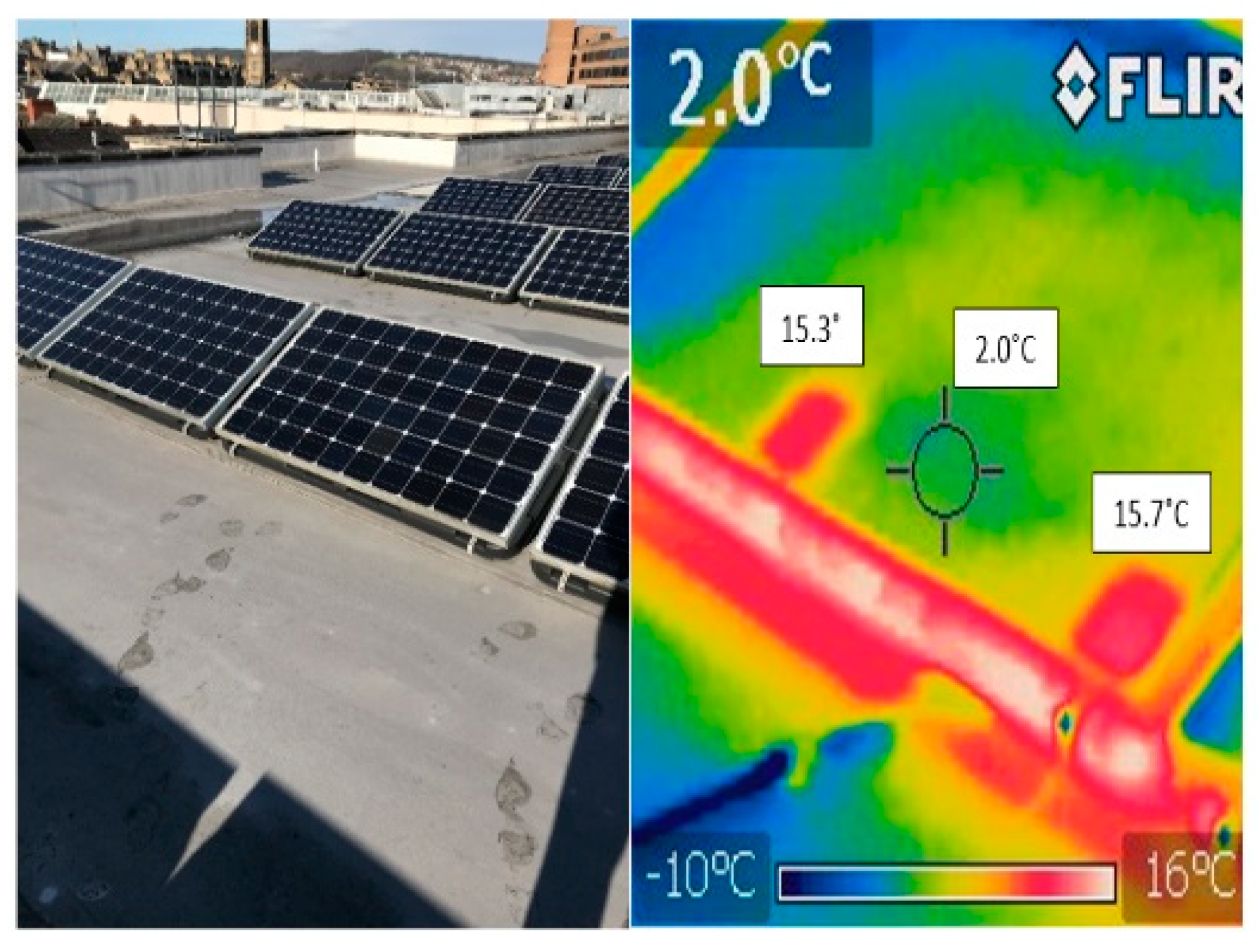
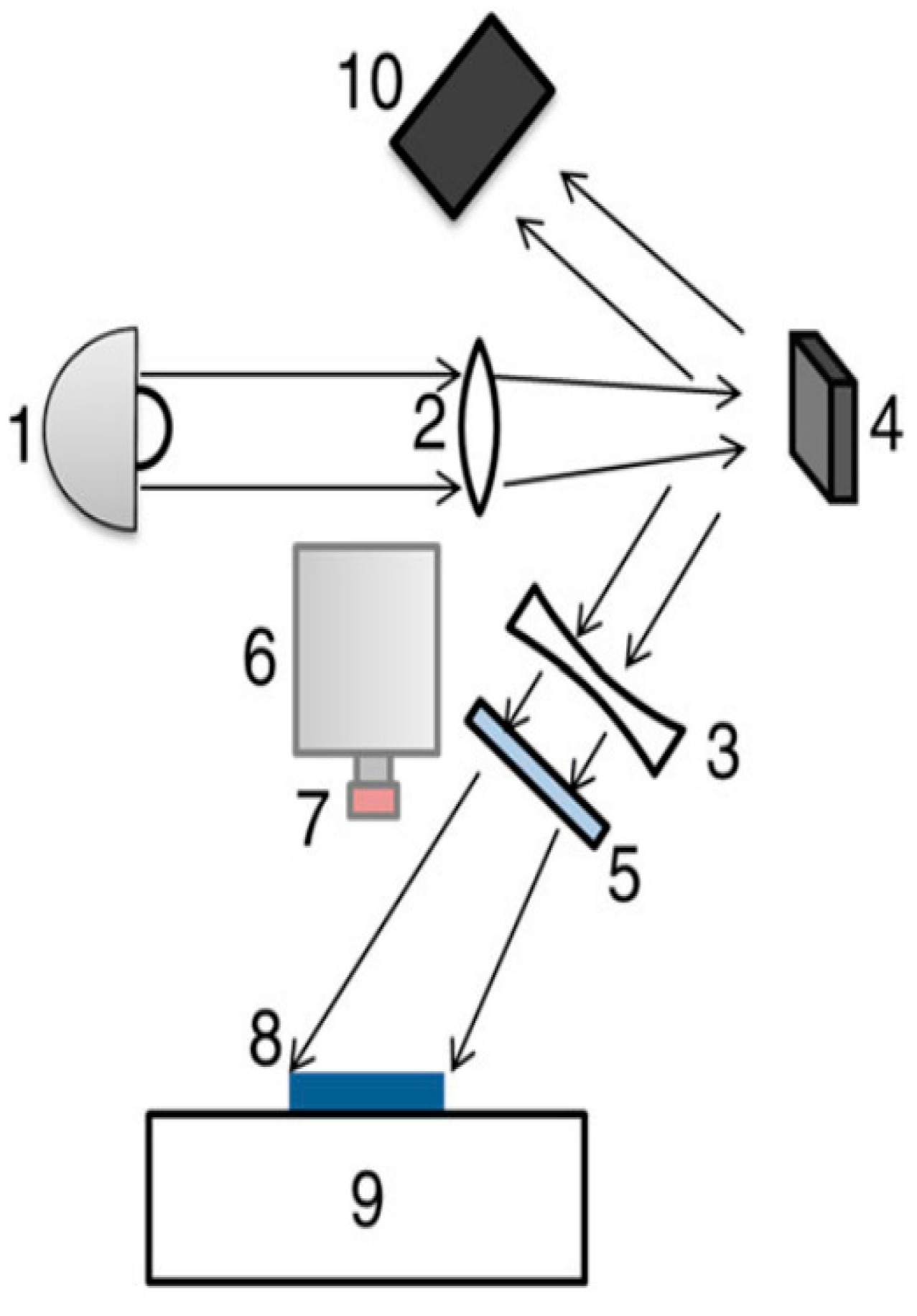

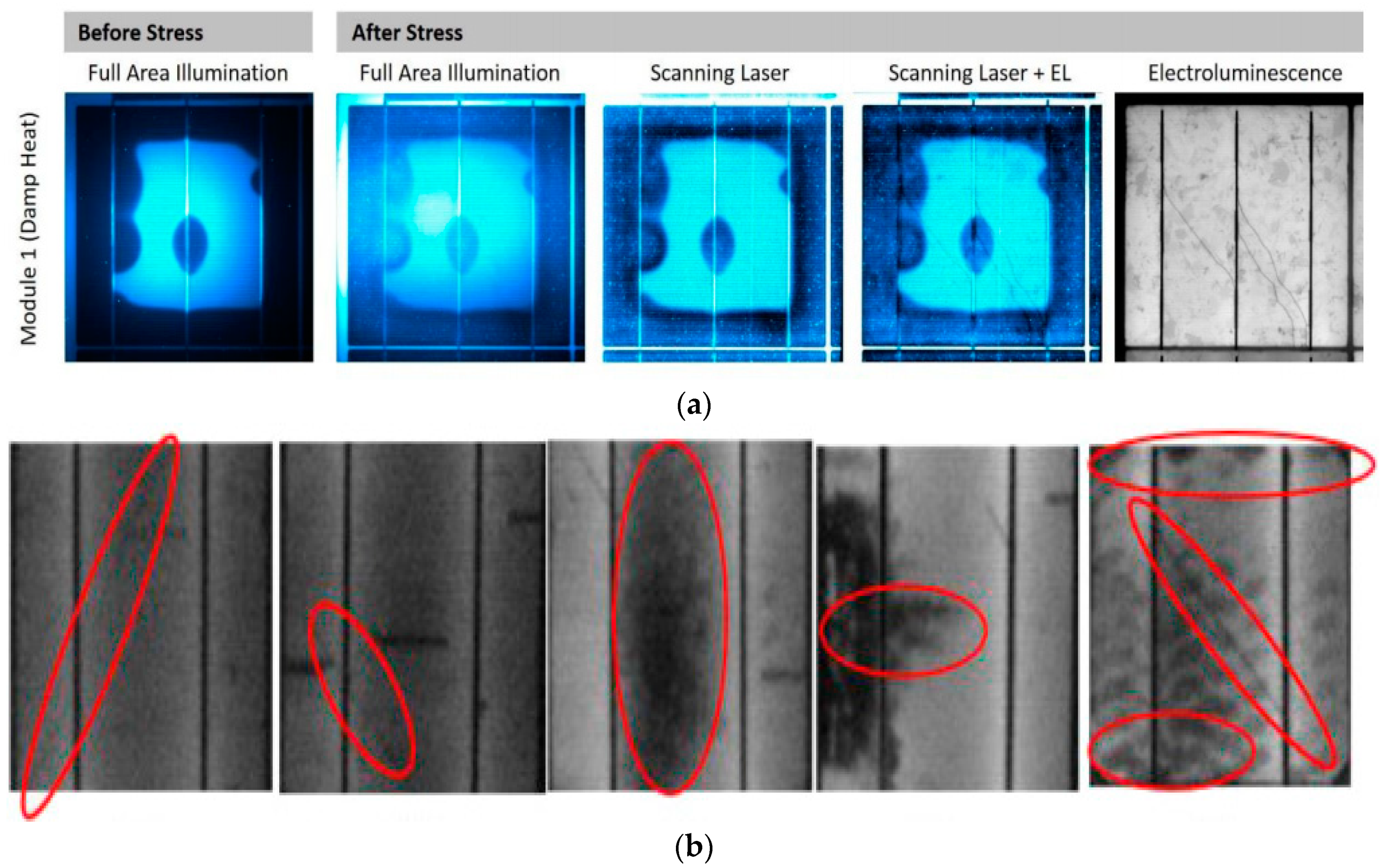
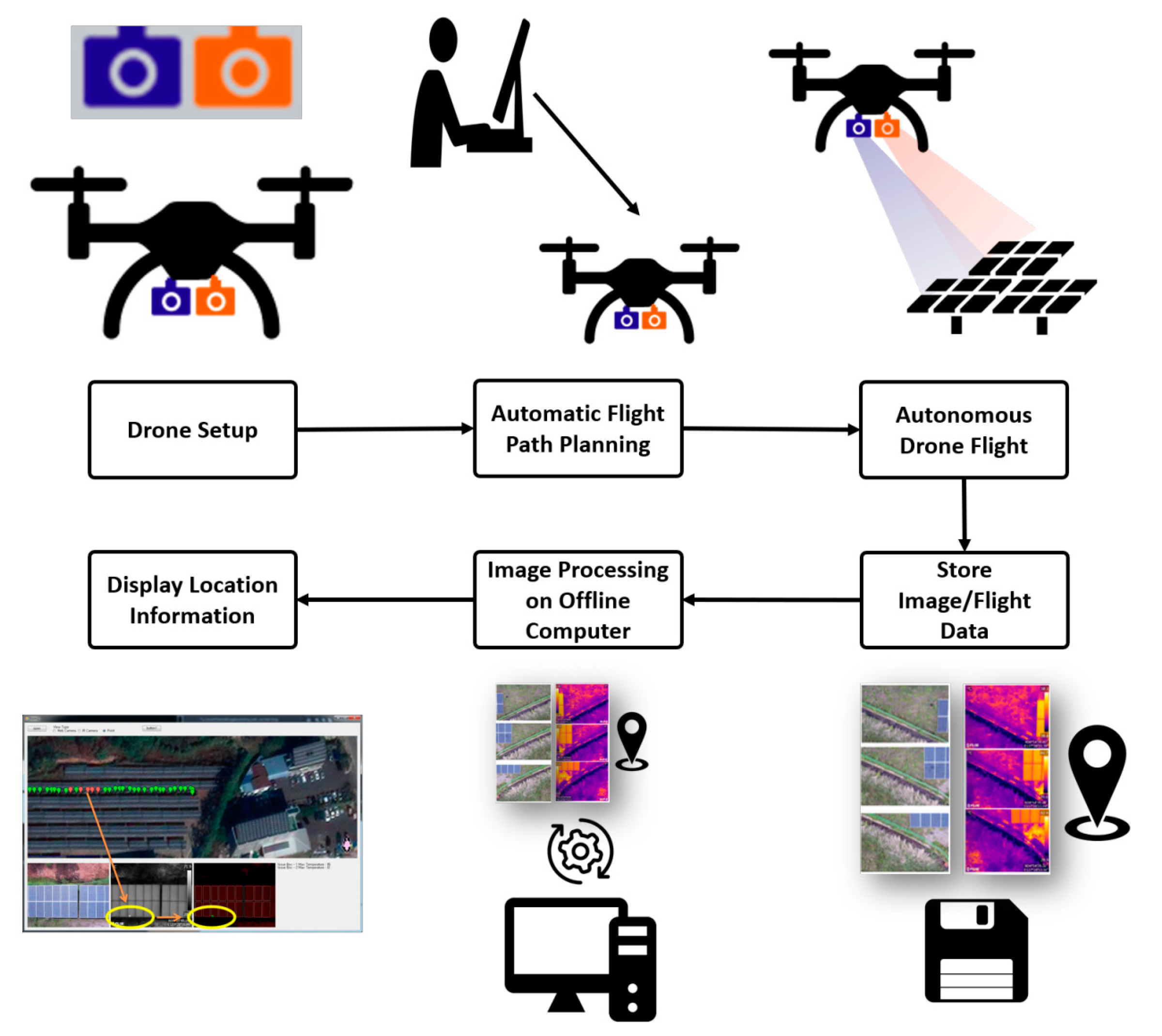
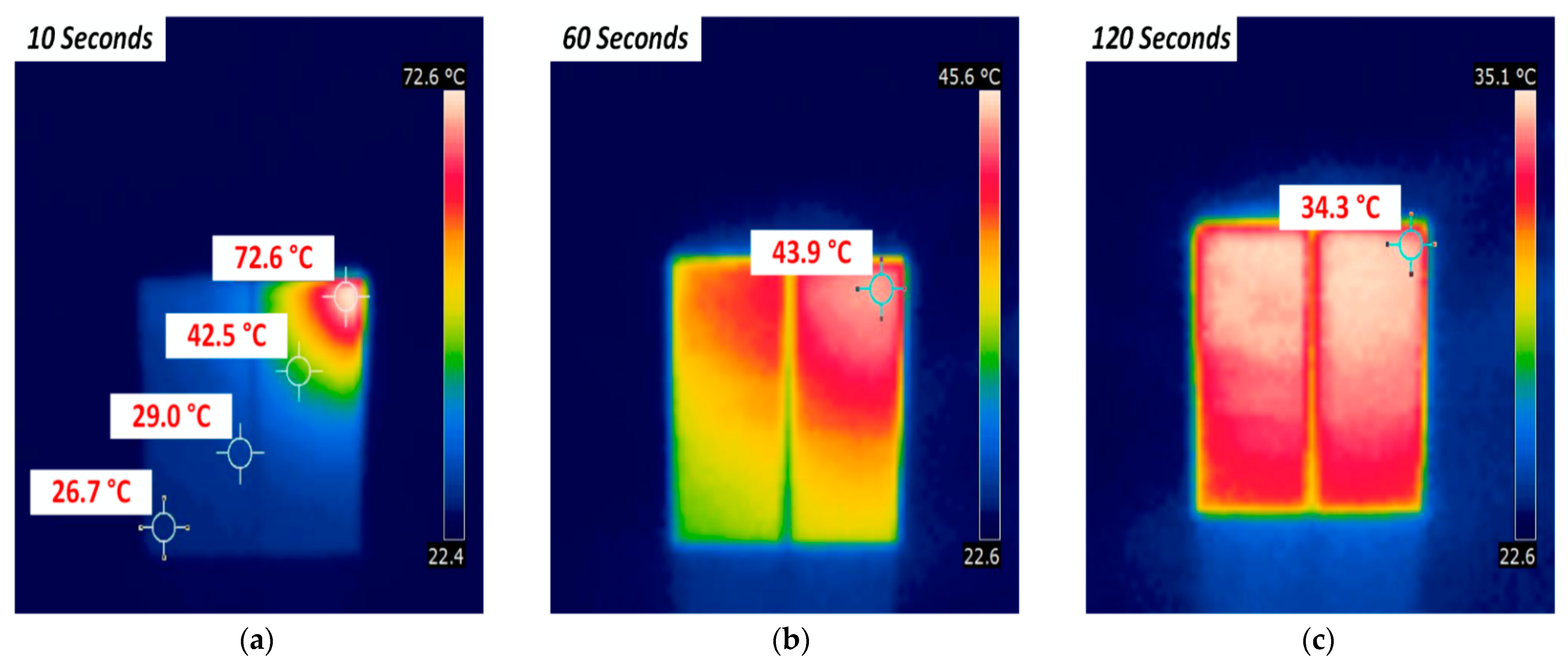
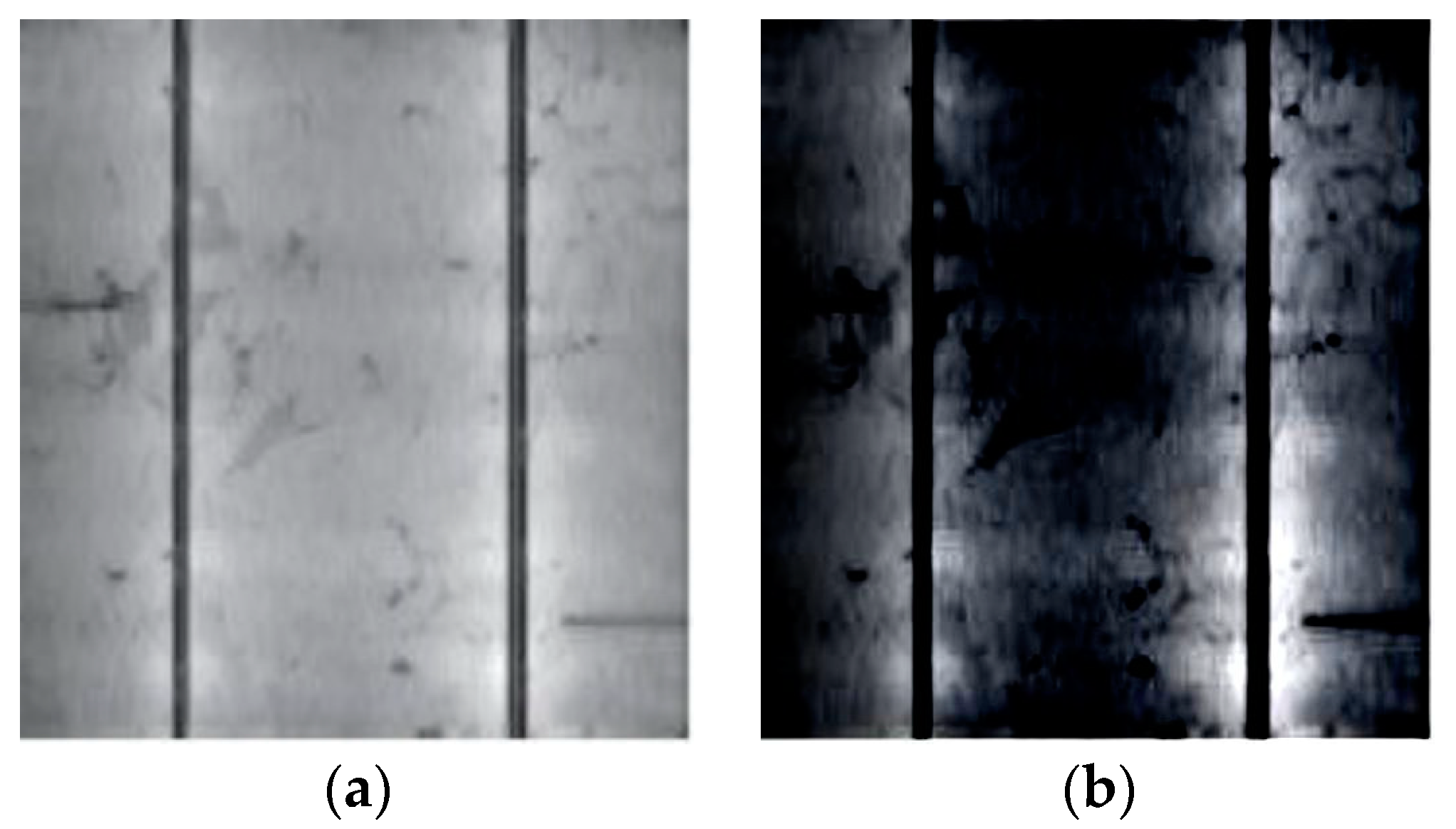

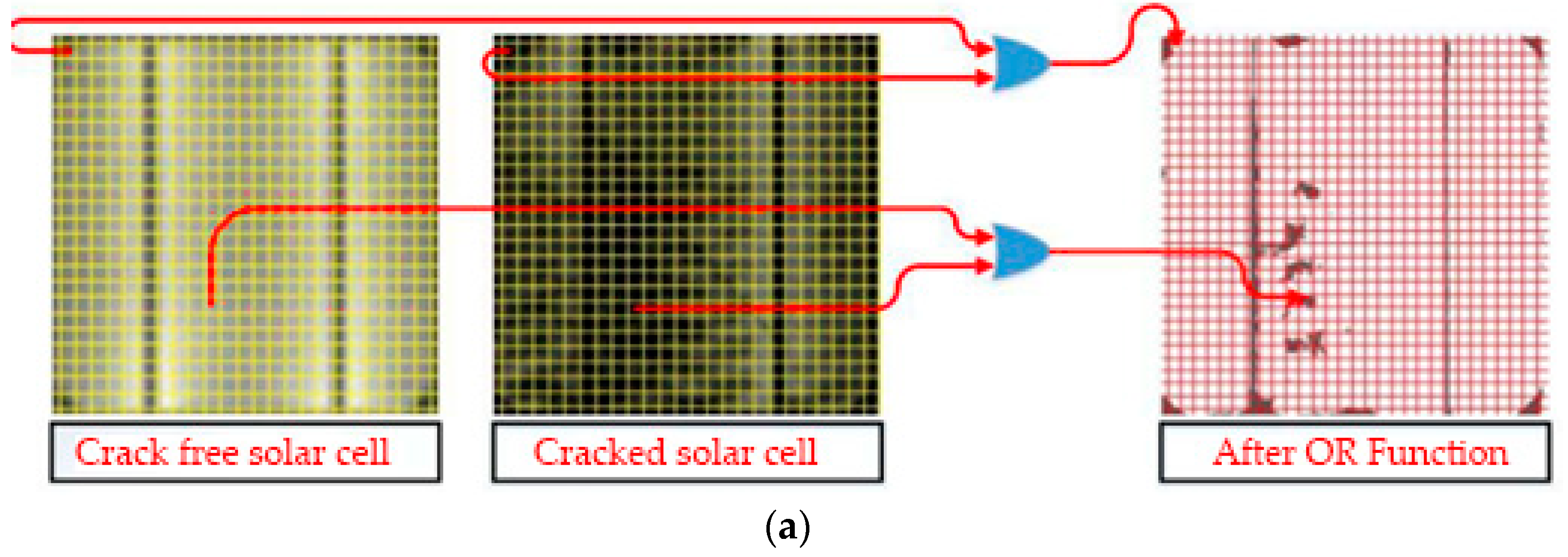
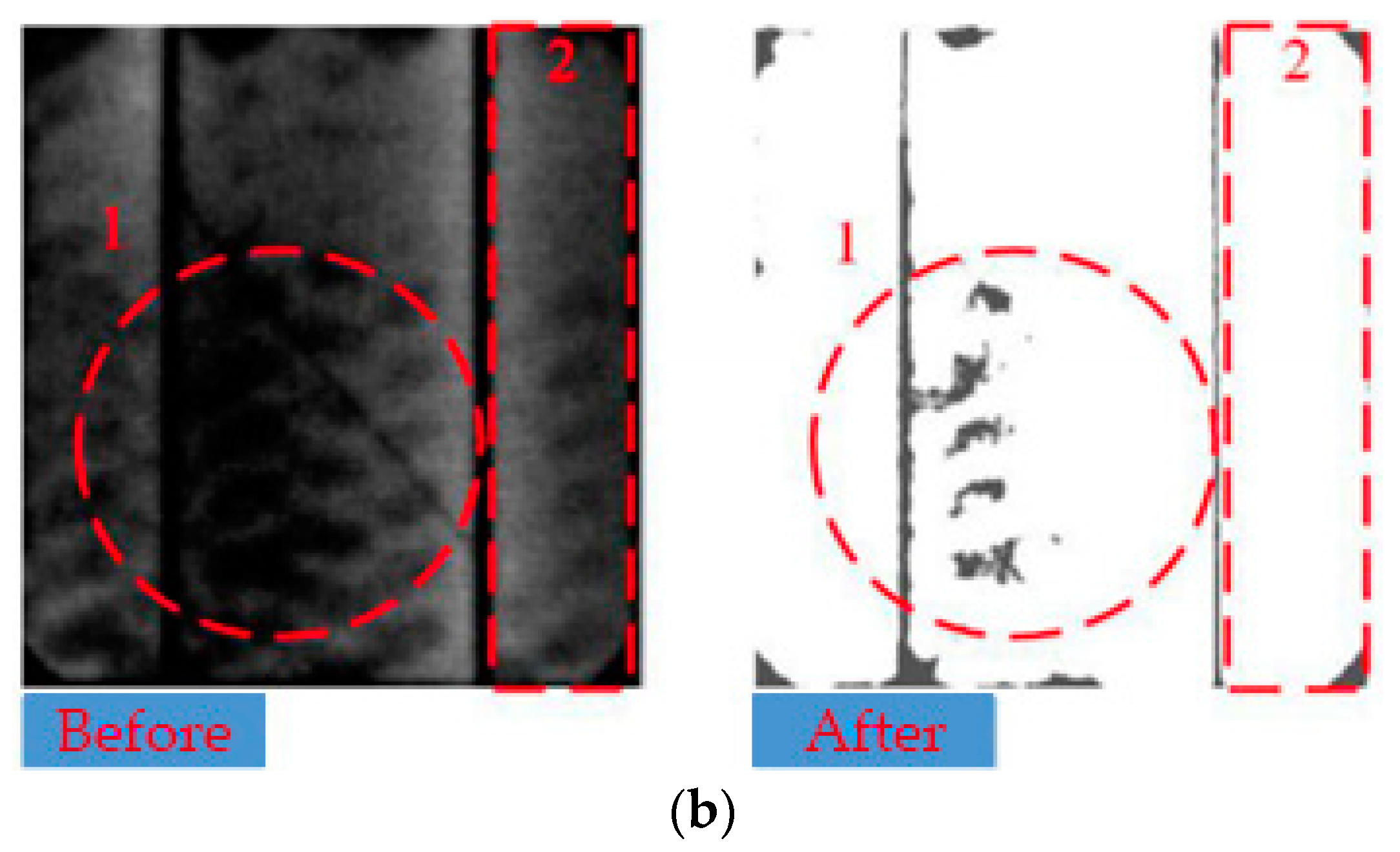
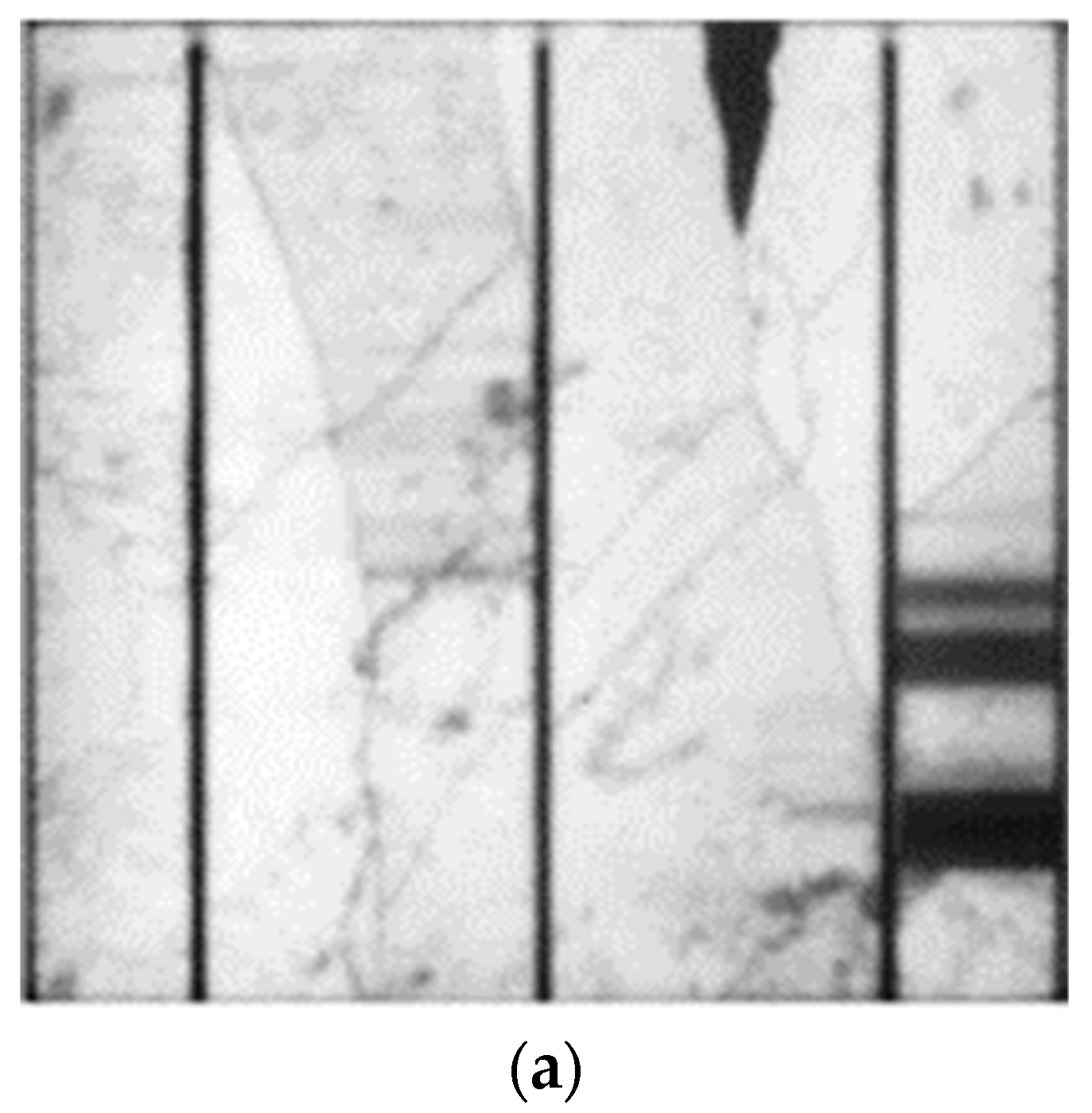
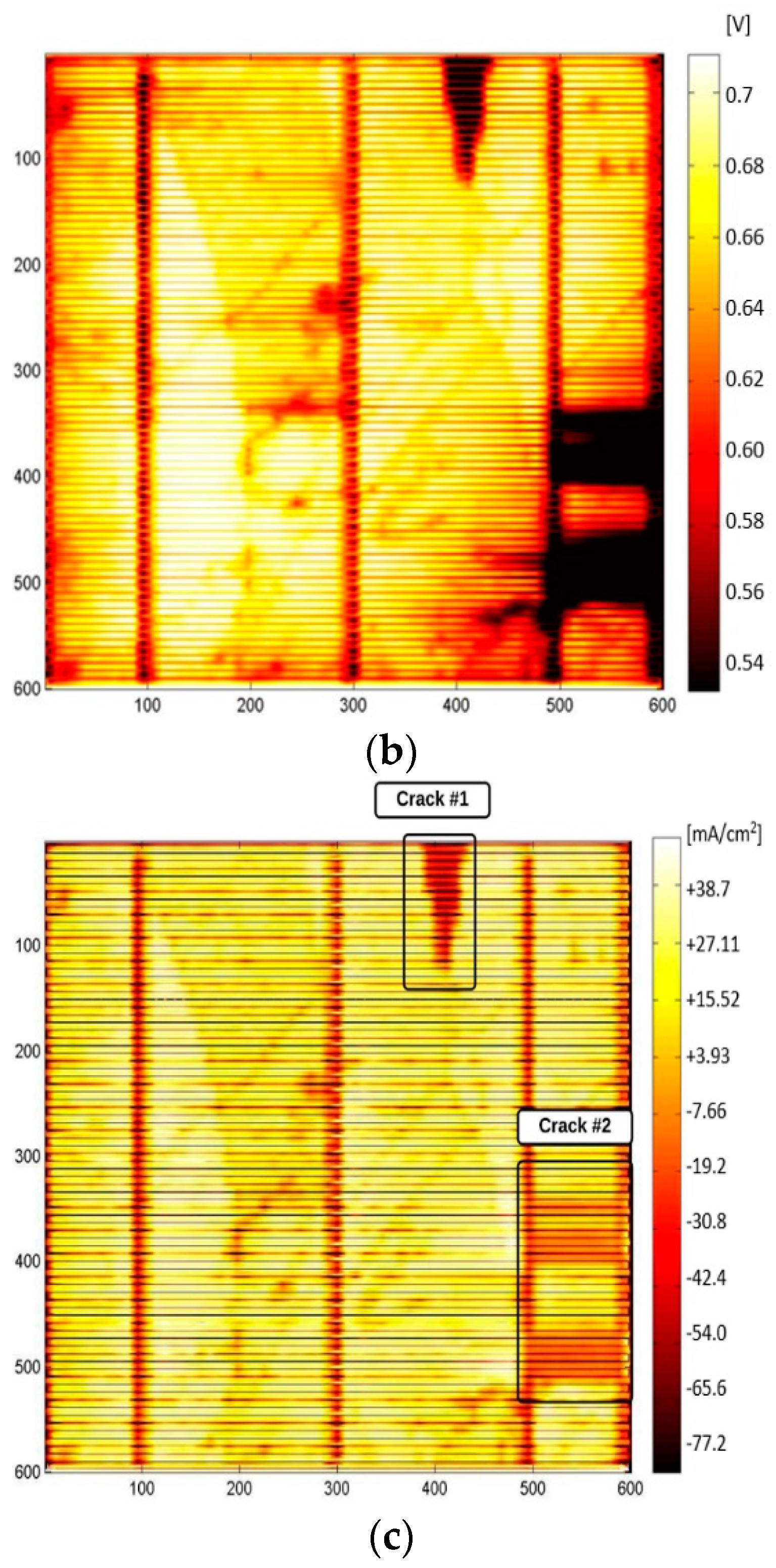
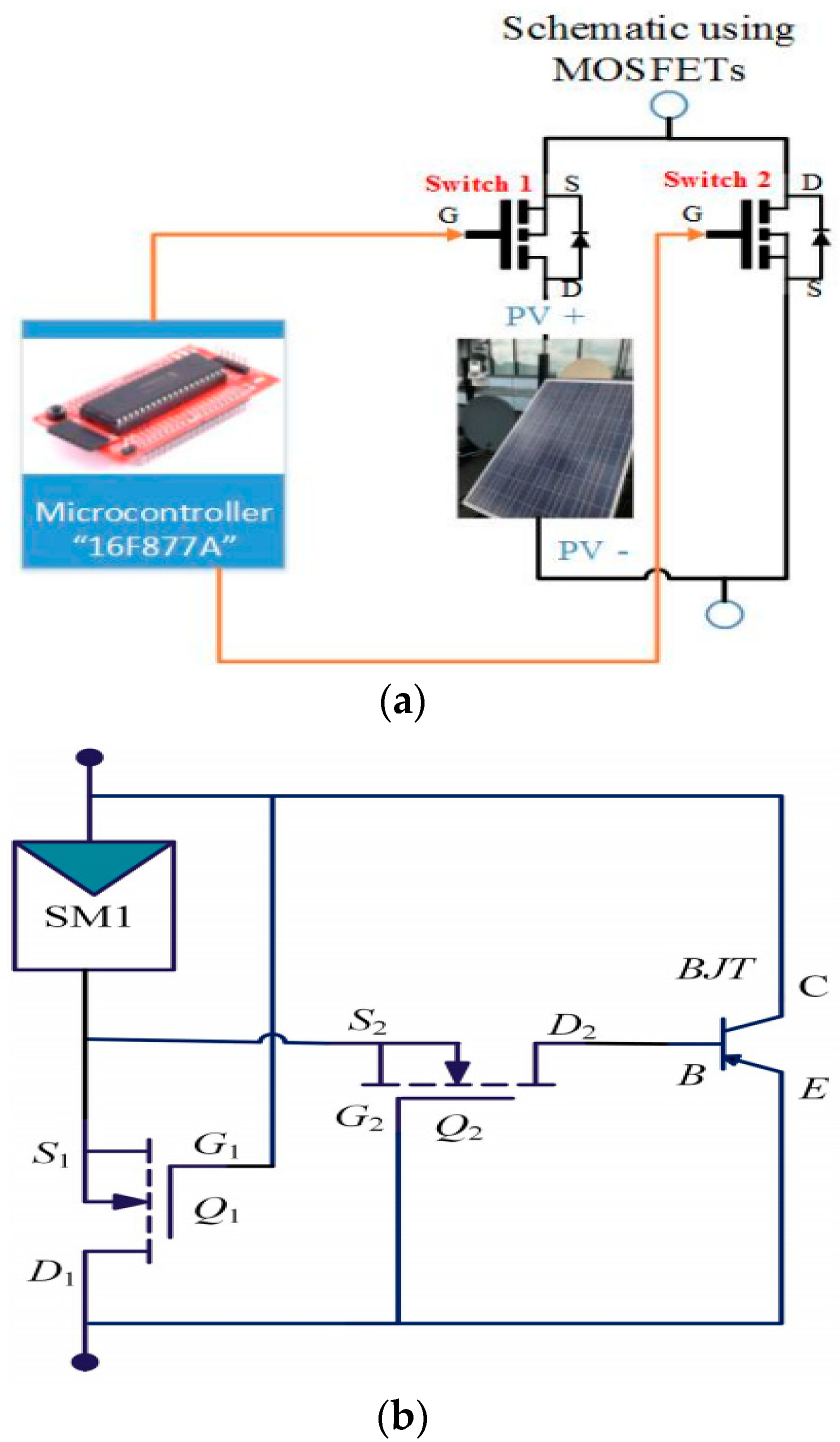
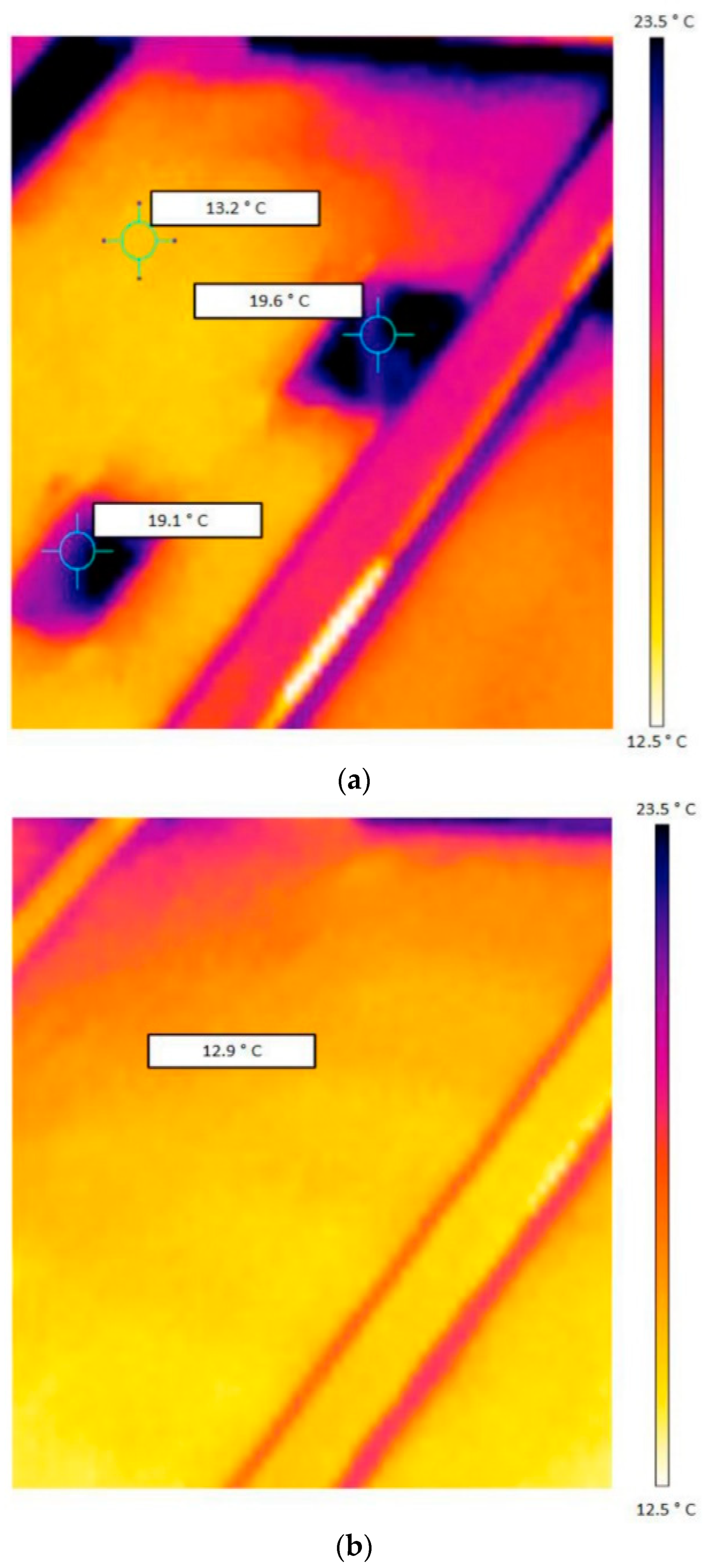
| Failure Mode | Cause Other Failures | Power Loss * | Detection |
|---|---|---|---|
| Yellowing/browning of encapsulants and back sheets |
| None | Simple detection method |
| Delamination of encapsulants and back sheet |
| Low | Requires technical equipment to detect, e.g., IP cameras |
| Bubble formation |
| Low | |
| Oxidation formation |
| Low | |
| Discoloration of busbars | Medium | ||
| Corrosion of connection and cracks of back sheet |
| Medium | |
| Hotspots | High | ||
| Cell breakage | Low–high ** | ||
| Microcracks |
| Low–high ** |
| PV Technology | Annual Measured Degradation Rate (%/year) | Degradation Rate Confidence Interval (%/Year) |
|---|---|---|
| Mono-Si | −0.81 | −0.78 to −0.83 |
| Poly-Si | −0.94 | −0.92 to −0.95 |
| CdTe | −1.43 | −1.41 to −1.45 |
| Reference | Cause/Origin | Mechanisms Impacting Degradation/Failure Severity |
|---|---|---|
| [47] | Degradation rates highly depend on location of installation | Higher and more unstable temperature, as well as higher humidity causes higher degradation rates. |
| [51] | Findings suggest microcracks to be the main cause of hotspots | Thermal imaging found an increase in temperature initiating from crack locations. Output power was found between 0.9% and 42.8%, depending on crack size. |
| [67,68] | Dissimilar materials within the laminate cause a CTE mismatch that induces thermomechanical stresses | These stresses are more present in the cells under the interconnection. The configuration of the interconnection ribbon was found to have significant influence on both crack initiation and propagation. |
| [49] | The most common degradation modes is encapsulant discoloration, which is approximated with linear decline | However, modules can also display non-linear declines that may be difficult to detect. Some of these invovle hotspots caused by cells or solder bonds and corrosion. |
| [50] | The most important and challenging cause of degradation in newer installations are hotspots followed by internal circuitry discoloration | Degradation rates are considerably higher in hot and humid climates than those in desert and mdoerate climates. |
| Reference | Indicator Type | Description of Indicator | Impact Severity |
|---|---|---|---|
| [52] | Crack orientation | Cracks parallel to and centered between busbars | Power drop of less than 4% |
| [52] | Crack orientation | Cracks parallel on both sides of both busbars | Power drop of 60% |
| [53] | Crack size | If area separated by microcrack in a solar cell is less than 8% | No power loss |
| [46] | Crack size | Diagonal and parallel orientation cracks | Significant power loss only when present in several cells and over enough area |
| [54,55] | Crack orientation | Vertical and multiple orierntation microcracks | Deemed as the most critical types causing significant power output drops |
| Comparison | [9] | [6] | Our Work |
|---|---|---|---|
| Outline and analysis of environmental factors causing performance drop | Some factors sporadically mentioned throughout | Environmental factors are outlined and analyzed | Environmental factors are outlined |
| Analysis of main performance drop causes | Yes, only for microcracks | Only mentioning of various failure modes | Yes, microcracks and hotspots that were found to be the most critical were analyzed in detail |
| Description and comparison of detection methods to analyze the cause of performance drop | No | Yes | Yes, for both in a relatively detailed manner |
| Suggestions for further work to aid in more PV performance predictions | Investigations to predict and quantify the long-term impact and propagation of cracking under different meteorological conditions | Further work in forecasting and modelling of environmnetal parameters with respect to solar plants | To investigate further the modelling of microcracks through processes such as XFEM used in combination with Griddler to determine PV performance output |
Publisher’s Note: MDPI stays neutral with regard to jurisdictional claims in published maps and institutional affiliations. |
© 2022 by the authors. Licensee MDPI, Basel, Switzerland. This article is an open access article distributed under the terms and conditions of the Creative Commons Attribution (CC BY) license (https://creativecommons.org/licenses/by/4.0/).
Share and Cite
Goudelis, G.; Lazaridis, P.I.; Dhimish, M. A Review of Models for Photovoltaic Crack and Hotspot Prediction. Energies 2022, 15, 4303. https://doi.org/10.3390/en15124303
Goudelis G, Lazaridis PI, Dhimish M. A Review of Models for Photovoltaic Crack and Hotspot Prediction. Energies. 2022; 15(12):4303. https://doi.org/10.3390/en15124303
Chicago/Turabian StyleGoudelis, Georgios, Pavlos I. Lazaridis, and Mahmoud Dhimish. 2022. "A Review of Models for Photovoltaic Crack and Hotspot Prediction" Energies 15, no. 12: 4303. https://doi.org/10.3390/en15124303
APA StyleGoudelis, G., Lazaridis, P. I., & Dhimish, M. (2022). A Review of Models for Photovoltaic Crack and Hotspot Prediction. Energies, 15(12), 4303. https://doi.org/10.3390/en15124303








